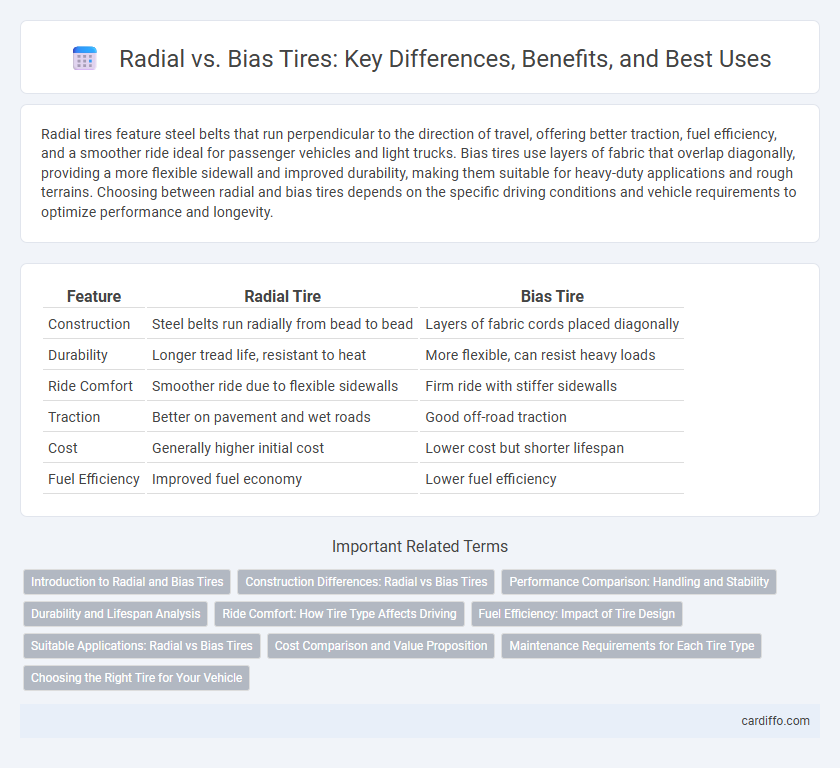Radial tires feature steel belts that run perpendicular to the direction of travel, offering better traction, fuel efficiency, and a smoother ride ideal for passenger vehicles and light trucks. Bias tires use layers of fabric that overlap diagonally, providing a more flexible sidewall and improved durability, making them suitable for heavy-duty applications and rough terrains. Choosing between radial and bias tires depends on the specific driving conditions and vehicle requirements to optimize performance and longevity.
Table of Comparison
| Feature | Radial Tire | Bias Tire |
|---|---|---|
| Construction | Steel belts run radially from bead to bead | Layers of fabric cords placed diagonally |
| Durability | Longer tread life, resistant to heat | More flexible, can resist heavy loads |
| Ride Comfort | Smoother ride due to flexible sidewalls | Firm ride with stiffer sidewalls |
| Traction | Better on pavement and wet roads | Good off-road traction |
| Cost | Generally higher initial cost | Lower cost but shorter lifespan |
| Fuel Efficiency | Improved fuel economy | Lower fuel efficiency |
Introduction to Radial and Bias Tires
Radial tires feature steel belts running perpendicular to the tread, offering enhanced flexibility, fuel efficiency, and longer tread life, making them ideal for modern vehicles. Bias tires consist of crisscrossed fabric plies that provide a tougher sidewall and better load distribution, often used in heavy-duty and off-road applications. Understanding the construction differences helps in choosing the right tire for performance, durability, and driving conditions.
Construction Differences: Radial vs Bias Tires
Radial tires feature steel belts running perpendicular to the tread and parallel to the direction of travel, enhancing flexibility and road contact for improved traction and fuel efficiency. Bias tires have multiple layers of fabric plies arranged diagonally at angles, providing a stiffer sidewall and durability ideal for heavy loads and rough terrain. The construction differences influence performance characteristics, with radial tires offering smoother rides and bias tires delivering greater resistance to punctures and sidewall damage.
Performance Comparison: Handling and Stability
Radial tires provide superior handling and stability due to their flexible sidewalls and robust belts, allowing for better road contact and improved traction during cornering. In contrast, bias tires feature crisscrossed plies that offer a stiffer sidewall, resulting in less precise handling and reduced stability at higher speeds. The enhanced lateral grip and heat dissipation of radial tires make them the preferred choice for performance-oriented vehicles and long-distance driving.
Durability and Lifespan Analysis
Radial tires feature steel belts running perpendicular to the tread, offering enhanced durability and longer lifespan compared to bias tires, which have layered plies at diagonal angles. The radial design reduces heat buildup and evenly distributes pressure, minimizing wear and extending tire life significantly. Bias tires tend to have shorter lifespans due to increased flexing and heat generation, which accelerates tread degradation and potential structural damage.
Ride Comfort: How Tire Type Affects Driving
Radial tires feature steel belts arranged at 90 degrees to the tread, providing superior flexibility and shock absorption that enhances ride comfort by smoothing out road irregularities. In contrast, bias tires have carcass plies laid diagonally, which results in a stiffer sidewall and a firmer ride, often transmitting more vibrations to the driver. The advanced construction of radial tires generally delivers a quieter, more comfortable driving experience, especially on rough or uneven surfaces.
Fuel Efficiency: Impact of Tire Design
Radial tires feature steel belts arranged perpendicular to the tread, reducing rolling resistance and improving fuel efficiency by up to 10% compared to bias tires. Bias tires have crisscrossed fabric plies that create more flex and heat buildup, leading to higher energy loss during driving. Choosing radial tires enhances vehicle mileage and lowers fuel consumption due to their optimized tread stability and reduced deformation.
Suitable Applications: Radial vs Bias Tires
Radial tires offer enhanced stability, better fuel efficiency, and longer tread life, making them ideal for highway and long-distance driving applications. Bias tires provide superior sidewall strength and durability, suited for off-road, heavy-duty, and agricultural uses where rugged terrain is prevalent. Selecting between radial and bias tires depends on the vehicle type and the specific driving conditions encountered.
Cost Comparison and Value Proposition
Radial tires generally offer a higher initial cost compared to bias tires due to advanced construction and materials, but their longer tread life and improved fuel efficiency provide greater long-term value. Bias tires feature a lower upfront price and simpler manufacturing process, making them cost-effective for short-term or budget-conscious use. Evaluating total cost of ownership, radial tires deliver superior performance and durability, enhancing overall value for most drivers.
Maintenance Requirements for Each Tire Type
Radial tires require less frequent maintenance due to their flexible sidewalls, which absorb road shocks better and reduce uneven tread wear. Bias tires demand more regular inspections and rotations because their stiffer sidewalls can lead to faster tread degradation and increased risk of damage under heavy loads. Proper tire pressure monitoring is essential for both types, but bias tires are particularly sensitive to underinflation, affecting their performance and lifespan.
Choosing the Right Tire for Your Vehicle
Radial tires feature steel belts running perpendicular to the tread, providing better fuel efficiency, longer tread life, and improved handling, making them ideal for passenger cars and light trucks. Bias tires have layers of fabric placed diagonally, offering a smoother ride on rough surfaces and increased durability in heavy-duty applications such as off-road or agricultural vehicles. Selecting the right tire depends on vehicle type, driving conditions, and performance needs, with radial tires preferred for everyday road use and bias tires suited for specialty or rugged terrain.
Radial vs Bias Infographic

 cardiffo.com
cardiffo.com